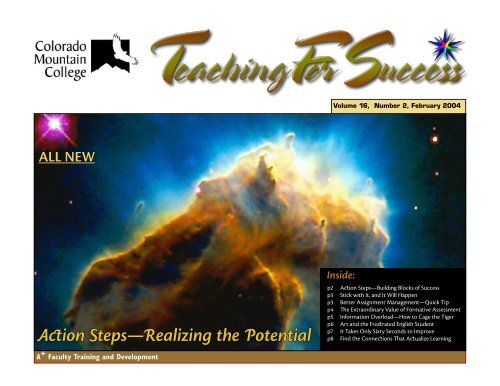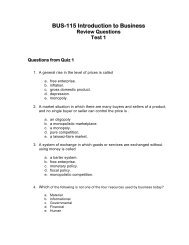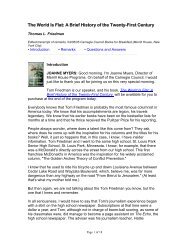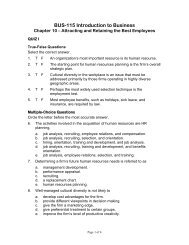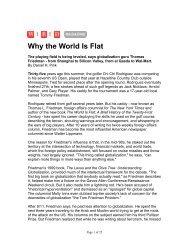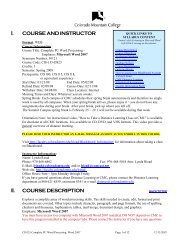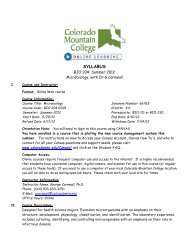February 2004
February 2004
February 2004
You also want an ePaper? Increase the reach of your titles
YUMPU automatically turns print PDFs into web optimized ePapers that Google loves.
Volume 16, Number 2, <strong>February</strong> <strong>2004</strong>ALL NEWAction Steps—Realizing the PotentialA + Faculty Training and DevelopmentInside:p2 Action Steps—Building Blocks of Successp3 Stick with It, and It Will Happenp3 Better Assignment Management—Quick Tipp4 The Extraordinary Value of Formative Assessmentp5 Information Overload—How to Cage the Tigerp6 Art and the Frustrated English Studentp7 It Takes Only Sixty Seconds to Improvep8 Find the Connections That Actualize Learning
Achievement Through Action StepsManagement—Critical Success FactorKey Ideas:Click to go!• Action steps astrategy for greatsuccess.• Patience andpersistence carrythe day.• Check sheets helpmanage assignments.• High-value formativeassessment.• Purge yourcourse of informationoverload.• Reading andpictures do gotogether.• Improve in 60seconds.• Connections rock.• Contest begins.TFS CriticalSuccess Factors ofGood Teaching:•Leadership•Management•Instructional Design•Communications•EvaluationTeaching For Success®<strong>February</strong> <strong>2004</strong>2Action Steps—BuildingBlocks of SuccessJack H. ShrawderPublisher/Editor TFSjack@teachingforsuccess.comIt’s a fascinating yet sometimes frustrating experienceto sit in a committee or board meeting andcompare the typical idea discussion, evaluationand application process used between highly successfulorganizations and those that flounder. One key toorganizations that succeed may be found in the numberand quality of actions steps proposed and completed.Good action steps arise from a:❑ Desire to improve.❑ Willingness to experiment and learn fromexperience.❑ Bias for doing it now.❑ Commitment to results.❑ Competent analysis of the context.❑ Passion for excellence, for doing it right.❑ Grasp of the system involved.❑ Solid confidence in a better future.Good action steps have the right:❑ Scope.❑ Complexity.❑ Focus.❑ Accountability.The number one characteristic of a good actionstep is its suitability for moderately-rapid completion.The most perfectly constructed and thought-outaction step is of no consequence if it never comes tofruition. What’s more, completing a series of relatedaction steps is a precursor to great success. Therefore,creating a step with the right scope of action is crucial.If a step is trivial, it will seem unimportant and becomeburied under the crush of the rush to deal with dailyemergencies. If the scope is too large, the action stepwill be put off under the perception that it will taketoo much time or effort to complete.An action step that blocks rather than facilitatesprogress may be too complex, or it may require toomany or too difficult-to-obtain resources to completewith modest effort in a reasonable time frame.With the correct focus, the completed action stepshould provide the information, data and motivationto continue to the next action step in the series.Most importantly, there needs to be the rightaccountability built into each action step. It must beabsolutely clear who is responsible for the completionof the step and what is the deadline for completion.A part of accountability is progress management.Step completion should be tracked. Do this by x-ing outan item on a simple checklist of steps, making entries ina project journal, log, sending an e-mail or traditionalmessage or presenting an oral report to the person orpersons with ultimate responsibility.The use of action steps is also applicable toteaching and learning. You can achieve excellentcourse management by creating meeting-, chapter- andcourse-level action steps for improving the teachingand learning process.Martin de Matt said, “You are pure potential.” To putthis potential to use, you need a solid success strategy.Learning how to create, manage and complete a series ofaction steps is a precursor to great success in life, learning andbusiness.For example, if you have taught a course morethan once, you should know the points that needimprovement. List these points and then construct aseries of action steps that will propel you toward thedesired revisions.If this is your first time teaching a course, use theaction-step principle on a weekly and daily basis tobetter prepare for each class meeting.Looking at learning applications, you couldintroduce action steps to your students. To grow asresponsible, accountable independent learners, theyshould learn to create a set of action steps for eachcourse. These steps could help them prepare for andcomplete major learning tasks such as term projects, ora series of chapter, midterm and final exams. Studentscould also build a set of action steps to manage theirweekly class homework load.You might even go so far as to relabel learningactivities with the much more elegant and energeticterm, “learning action steps.” This reinforces the ideathat students are ultimately in charge of their learningand need good self-management strategies. Finally,when students are given the responsibility to createand complete a series of action steps, this leads to theinternalization of a success strategy that will be usefulfor the rest of their lives.TFS Action StepSelect one improvement you’d like to make, andcreate a series of action steps necessary to implementthis change. Then, commit to complete each step.
Finding SuccessLeadership—Critical Success FactorKey Ideas:Click to go!• Action steps astrategy for greatsuccess.• Patience andpersistence carrythe day.• Check sheets helpmanage assignments.• High-value formativeassessment.• Purge yourcourse of informationoverload.• Reading andpictures do gotogether.• Improve in 60seconds.• Connections rock.• Contest begins.TFS CriticalSuccess Factors ofGood Teaching:•Leadership•Management•Instructional Design•Communications•EvaluationTeaching For Success®<strong>February</strong> <strong>2004</strong>3Stick with It, andIt Will HappenWilliam WardPlant ManagerPalo Verde County Water DistrictPalo Verde, CApvwaterworks@earthlink.netAfter three-and-a-half years of teaching watertechnology training for Rio Salado College toinmates, I have come to realize that teaching,if successful, must be approached as more than a job.The word “job” as used here connotes a do-onlywhat’s-necessary,minimum-effort, minimum-timework approach. Teaching, successful teaching, is neveran effortless endeavor. Teachers, good, teachers, arepassionate about their work, and their passion hasno limits. This is what makes “Teaching For Success”successful—passion, caring and extra effort.In the pages of Teaching For Success, Teachersshare their passions and indeed, their love of teaching.Good instructors—those who are dedicated andhardworking constantly seek ideas and ways to improvetheir teaching. They constantly search, research andapply different methods to enhance their performancelevel and the performance level of their students.Feedback and evaluation are key ways to determinethe effectiveness of these methods. A good instructoris opened-minded, critical of himself and his methodsand able to accept criticism.The pursuit of perfecting or at least of improvingourselves and our programs is never ending. But towhat end should one strive for? What is the ultimategoal? Perfection? No! The goal is success.I taught inmates in a Rio Salado College programat Lewis Prison, Arizona. At the end of instructionalsequence or program, Iasked, “Was I successful?Was I instrumental inchanging lives?” I askbecause that’s mypassion, my love.Many of you maynever be able to answerthat question to yoursatisfaction. Because,sometimes to teach is togive and not be assured New learning, new life.that you made a difference.When times are tough and you need assurance,take a moment to list your students who have:❑ Successfully completed college credits ora certificate or degree program.❑ Found employment.❑ Given you a special thank you for helpingthem.❑ Discovered their motivation to continuein college.However, to me, the burning questions to ask are:“Was I successful?” and “Did I have an influence on mystudents lives?” Fortunately, my answer to both questionsis a resounding yes! I have confirmed that 16 inmates, asthe direct result of the Rio Salado College program havetaken jobs in water technology field upon their releasefrom prison.To further add to my feelings of great satisfaction,I have encountered two former inmates at a watertechnology conference. It’s my hope and desire that allof you may know the fruits of your labors too. I hope thisarticle is an encouragement to you no matter how bleakor discouraging your situation seems; the rewards areheartwarming. To quote part of a letter received from aformer student, “Stick with it guys; it will happen.”Better AssignmentManagement—Quick TipKathy HoganDevelopmental. Math Dept.Clinton Community College1000 Lincoln Blvd.Clinton, IA 52732To assist my students, I hand out a special assignmentsheet to my classes on the first day of anew chapter. It lists the assignments for thechapter as well as extra-credit options.Students use this form as a cover sheet when theyhand in their assignments at the end of the chapter.I check off the assignments that I receive giving thestudents proof of acceptance. I circle the ones thatare missing.This sheet helps in a couple ways. The students knowahead of time what the assignments will be so, if theyare absent form class, they know what the assignmentis. (My syllabus lists the section to be discussed eachday.) It also helps explain their homework gradecalculation to them. Students can easily spot missingassignments and quickly understand where pointswere earned or lost.The extra-credit options have been a benefit aswell. These problems are more challenging at timesand the cumulative review is of much benefit to them.My students have commented on how much theyappreciate this chapter assignment sheet and howwell it works for them.TFS Action StepAnalyze your current assignment managementprocess. Develop a job aid similar to Kathy Hogan’sassignment sheet and evaluate it with your class.
Formative AssessmentEvaluation and Testing—Critical Success FactorKey Ideas:Click to go!• Action steps astrategy for greatsuccess.• Patience andpersistence carrythe day.• Check sheets helpmanage assignments.• High-value formativeassessment.• Purge yourcourse of informationoverload.• Reading andpictures do gotogether.• Improve in 60seconds.• Connections rock.• Contest begins.TFS CriticalSuccess Factors ofGood Teaching:•Leadership•Management•Instructional Design•Communications•EvaluationTeaching For Success®<strong>February</strong> <strong>2004</strong>4The Extraordinary Valueof Formative AssessmentBrian R. Shmaefsky, Ph.D., TFS Partner EditorBiology & Environmental SciencesKingwood CollegeKingwood, TXbrian.shmaefsky@nhmccd.eduIt is all too common to hear science colleagueslamenting the low scores a class of students justachieved on a recent test. However, some of theplaintive mood is broken by the humorous repliesstudents provide on exams. Many of these inaccurate,but entertaining, answers make their way into booksand e-mails. Some may be fabricated. Yet, many areconfirmed true because instructors regularly comeacross similar responses to their test questions.Comical answers to test questions are a laughingmatter only under two conditions. The first conditionis if the student knows the answer and decides to writeit accurately but with humor. A purposely incorrectanswer with a witty twist is also acceptable. The studentknows they do not have the information, but chooseadd humor to the dismal situation. Below are samplehumorous answers assembled from science tests:❑ A liter is a nest of young puppies.❑ For head colds use an agonizer to spray thenose until the unit drops in your throat.❑ The tides are a fight between the Earthand the moon. All water tends towardsthe moon, because there is no water on themoon, and nature abhors a vacuum. I forgotwhere the sun joins in on this fight.❑ A fossil is an extinct animal. The older itis, the more extinct it is.“What? Me jokearound on a test?”❑ The pistol of a flower is its only protectionagainst insects.❑ A super saturated solution is one thatholds more than it can hold.❑ When you smell an odorless gas, it’sprobably carbon monoxide.These answers are not funny if the students trulybelieves that their responses are correct. Scienceinstructors must be alert to the consequences of theseanswers. Most obvious are the students who do notknow the concept well enough to provide accurateinformation for answering a simple question. Thelong-term consequence is that the testing does notteach the student the correct answer. It penalizes themfor getting it wrong. So, the student’s grasp of sciencebecomes further diluted as they accumulate moreconcepts built on that prior knowledge.Adding various types of formative evaluationinto the curriculum helps faculty catch studentmisinformation about critical science concepts.Remember, formative evaluation means testing solelyfor the purpose of monitoring student comprehensionof a related set of concepts. It should not be used as amajor factor in student grading. Formative evaluation isa learning tool for faculty and students. Faculty gage thereach of their students’ understanding; students learnwhat they do and do not know about the concepts.Successful formative evaluation requires that:❑ It’s given frequently, at the end of a complextopic or at least every other week.❑ It’s given unannounced or immediatelybefore the next class session.❑ The questions must be consistent with thelecture and any graded testing.❑ The questions measure higher-levelthinking as well as factual recall.❑ Various formats are used such as multiplechoicequestion, short answers andproblem-solving essays.❑ Correct answers are provided immediatelyafter the evaluation.❑ Students are encouraged to use theassessment as a study guide.❑ It’s not a factor in grading.So, what should a formative evaluation strategylook like? First, you provide a presentation about atopic that covers two or three major concepts. Forexample, a physics lecture covers the principles ofcircular and linear motion.Note: This topic requires rules and mathematicalequations that must be memorized and applied tosolve problems. Concepts such as force, friction, gravity,inertia, kinetic energy, potential energy and vectors areinvolved in understanding this topic.Next, assign the students any traditional studyaids or homework for reinforcing the concepts. Then,at a later session, present students with a short testor a brief hand-in assignment. Continue by askingyour students to go over the answers while providingconstructive feedback.Formative Assessment continued on page 5
Keeping Students InformedCommunications—Critical Success FactorKey Ideas:Click to go!• Action steps astrategy for greatsuccess.• Patience andpersistence carrythe day.• Check sheets helpmanage assignments.• High-value formativeassessment.• Purge yourcourse of informationoverload.• Reading andpictures do gotogether.• Improve in 60seconds.• Connections rock.• Contest begins.TFS CriticalSuccess Factors ofGood Teaching:•Leadership•Management•Instructional Design•Communications•EvaluationTeaching For Success®<strong>February</strong> <strong>2004</strong>5Information Overload—How to Cage the TigerCara E. Taylor, TFS Partner AuthorBaker College of MuskegonMuskegon, MIcarataylor@aol.comToo often, students are overwhelmed with a surplusof course information; this causes misseddeadlines and misunderstood requirements.To some students, it may seem impossible to keepit all organized. Keeping the lines of communicationopen between the instructor and student is essential;moments of frustration or ambiguity often arise whenissues aren’t discussed with clarity and creativity. It maytake some innovation on the part of the instructor tocope with the effects of information overload.Ideally, students should be aware of the long-termrequirements for the course, which are listed in the classsyllabus. However, frequent reminders of assignmentsdue, chapters to be read, discussion topics, etc. mustbe issued to keep students on track. Here are severalways that I use to cage this paper tiger.Daily agendaFirst, at the outset of each class session, post theday’s agenda on the board. To eliminate any confusion,title the agenda with the date. Alternating with vibrantcolors, list all activities that will be accomplished duringthe class session. Think of captivating titles that willspark interest and curiosity among the students abouteach planned activity. For example, reviewing Chapter 7for a geography class could be better listed as “ChattingAbout China.” Highlight the break time, and note whenstudents are to return to class. End the daily agendawith a positive comment, such as “Head for Home” or“See You Next Wednesday.” Students will appreciateknowing what to expect for the next class session.Course newsletterAnother organizational technique is to create acourse newsletter [paper or electronic]. Headline thenewsletter with a catchy title, such as “The CalculusConnection” or “History 101 Highlights.” To energizethe document, include an inspirational quote at thetop. Next, in a table format, list assignments andreadings that are due for that week and the followingweek. The remainder of the newsletter can be usedto highlight important information that may includespecific assignment requirements, changes in thesyllabus, answers to student questions, or clarificationof course issues.Student mailboxesTo reduce the time consuming task of deliveringhandouts and returning assignments, provide studentswith their own mailboxes. This can easily be donewith a plastic crate and file folders. Label each filefolder with the student’s name and place it in thecrate alphabetically. Before each class, fill the student’smailboxes with handouts they will be using for thatsession. Include chapter outlines, activities to be donethat day, or graded assignments. Place the crate in alocation near the door, so students can get their mailwhen they enter class.Refining course communications and addingchannels means more valuable class time will beavailable for learning tasks. This is a double win.TFS Action StepIdentify your classes communication’s bottlenecks.Select or create your own method to improve studentcommunications. Test it this week.Formative Assessment continued from page 4Next, request that the students hand in theassessment so you can evaluate the level ofunderstanding. Review the concepts if many of yourstudents do not grasp them. Suggest tutoring forstudents who have not satisfactorily learned thematerial. Lastly, return the assessments so that studentscan use them as a studying tool.The formative assessment strategy outlined in thisexample uses traditional testing methods. However,you can use other approaches to evaluating studentcomprehension. For example, “game show” typeverbal quizzes and problem-solving group activitiescan be used alone or in conjunction with traditionalassessment methods. Formative assessment isa proven instructional supplement supportedby years of educational research. Unfortunately,college instruction too often makes little use of thisextraordinary pedagogical aid.ReferencesGeis, George L.; Formative Evaluation: DevelopmentalTesting and Expert Review. Performance and Instruction26, no. 4 (1992): 1-8.Kushner, S. Personalizing Evaluation London: Sage.2000.Pawson, R. & Tilley, N. Realistic Evaluation London:Sage. 1997.Scriven, M. “The methodology of evaluation”. Worthen,B. R. & Sanders, J. R. (eds) Educational Evaluation:theory and practice Belmont, Cal. Wadsworth.1973.TFS Action StepAdd a traditional or alternative formativeassessment plan to your course, and then evaluatethe results.
Adding Visual LearningInstructional Design—Critical Success FactorKey Ideas:Click to go!• Action steps astrategy for greatsuccess.• Patience andpersistence carrythe day.• Check sheets helpmanage assignments.• High-value formativeassessment.• Purge yourcourse of informationoverload.• Reading andpictures do gotogether.• Improve in 60seconds.• Connections rock.• Contest begins.TFS CriticalSuccess Factors ofGood Teaching:•Leadership•Management•Instructional Design•Communications•EvaluationTeaching For Success®<strong>February</strong> <strong>2004</strong>6Art and the FrustratedEnglish StudentMuriel RyanIVY Tech CollegeTerra Haute, IN 47802mollysweet@hotmail.comEnthusiastic chatter fills the room as materialsare distributed. Students hunt for favorite colorsand lay their tools before them. This pictureseems very atypical for a classroom of freshmanEnglish students.These students taking English 031 and 032 havefallen under the reading comprehension standard setfor incoming freshmen. These are my students. Theiracademic histories vary. Some did reasonably wellin school, but it required many hours of studying toovercome a difficulty in remembering what they read.Some can read and pronounce each word, but find ita challenge to glean the meaning from the text. A fewfound high school a never ending frustration with fewoccasions to ever feel successful.My job is to increase their skill and confidence whenreading new material, increase their comprehensionby developing their study habits and challenge themto become more analytical readers.Probably the most formidable part of this teachingis helping them to integrate all the skills taught inthis class. Much of the time is spent learning newvocabulary, practicing study skills related to annotationand completing rather dull comprehension drills.Therefore, I find visualization learning activitieslifts their spirits and confidence as they do somethingcreative and fun. So I bring on the markers and theconstruction paper and put a bit of color and punchinto the classroom.In this learning mode, students are expected todemonstrate their learning by completing a visualproject to demonstrate their level of understanding.When they express abstract concepts in concreteterms, their creations are a good indicator of theircomprehension level. Art allows them to process theinformation given in lecture and practice in a newmode. By the use of color and their imagination, theycan express learned English concepts in their ownconstructs.Using this method, the products will be as varied asthe individual students. Employing visual methods thestudents are instructed to communicate concepts to eachother using the skills used by good readers.For example, one drew a car engine and labeledthe parts that drive the reader. The spark plugswere labeled vocabulary indicating the importanceof knowing words and their meaning. The pistonsrepresented the author’s organizational methods thatgenerate the power behind the way the author selectswords and places them in a specific order to logicallypresent ideas.Another student organized reading skills on neatbook shelves. Each shelf had a different resource forthe student to use in understanding challenging texts.Another student took the same information and placedeach resource on the pedals of a daisy with the centerlabeled “Critical Reader.”Using this teachingE a c h s t u d e n tmethod, the products visualized the interplaywill be as varied as the of reading skills andindividual students.resources and thentranslated that vision topaper.Another advantage to this method is that it requiresstudents to review previously presented material. Thisallows practice to be stimulating and not as rote. Italso sets a stage for the natural transference to a moresophisticated method of imagining facts and conceptsin alternative forms.For example, this can naturally lead to the use ofVenn diagrams that show the relationships of charactersin a narrative or the supporting details of a mainidea. Flow charts become a logical outgrowth of thistechnique. Lastly, this method clarifies and increases thevisual images used in learning thereby aiding studentswho are visual learners to be successful. This activity isa sensible complement to the often used lecture whichfavors students who are strong auditory learners.By encouraging students to see, create, select andorganize images, it places information in a familiar andcomfortable context. As an instructional method, it’samazing how colored markers and paper can combineto create a successful alternative learning mode.When seeking student feedback on my courses as awhole, the markers and construction paper activities isoften cited. These sessions are perceived as memorable,fun and interesting. Each student looks forward todoing it again and again.TFS Action StepAdd a component of drawing, art or creativevisualization to your instructional design. Plan agroup or cooperative learning activity involving theseconcepts. Ask for student reactions.
Stay on Course with Real-time FeedbackEvaluation and Testing—Critical Success FactorKey Ideas:Click to go!• Action steps astrategy for greatsuccess.• Patience andpersistence carrythe day.• Check sheets helpmanage assignments.• High-value formativeassessment.• Purge yourcourse of informationoverload.• Reading andpictures do gotogether.• Improve in 60seconds.• Connections rock.• Contest begins.TFS CriticalSuccess Factors ofGood Teaching:•Leadership•Management•Instructional Design•Communications•EvaluationTeaching For Success®<strong>February</strong> <strong>2004</strong>7It Takes Only Sixty Secondsto Improve—Here’s HowDonald A Petkus, TFS Partner AuthorIndiana UniversityBloomington, INpetkus@indiana.eduThe one-minute paper has been around for some time, but it’s well worthrevisiting because of what it can do for you and your students. It providesyou with a chance for obtaining quick feedback on how your studentsfeel their progress is going. It gives students a chance to say, “I don’t understand”without having to draw attention to themselves in class.It also gives them a chance to say, “I get it, already!” when you spend too muchtime on a concept or skill that they feel they have mastered. Also, it producesimportant information needed to customize your next class lecture notes or plana carefully targeted review session.Although the one-minute paper calls for informal, spontaneous writing, it alsooffers another way to assess our students’ writing skills, learning styles, criticalthinking skills and content mastery. Most importantly, it helps us to improve ourteaching.What is a one-minute paper?The format for a one-minute paper is simple and concise for students. Here isthe variation that I recommend. Toward the end of a class session, ask your studentsto pull out a sheet of paper. Sometimes there may be groans and expectations ofa pop quiz.But just proceed and direct them NOT to put their names on these papers. Thisis going to be anonymous exercise. That usually lowers their stress level immediatelyand piques some interest. Anonymity allows them to be more candid about yourteaching style and practices.Now explain to them you want frank answers to two general questions:❑ What did you learn best in today’s class? Anything new or interesting?Do you feel that you mastered this concept or skill?❑ Second question, what concept or idea do you think you understandthe least? In other words, what do wish that your instructor would goover again or explain more clearly?You may need to addmore time or try adifferent approach. Look forthemes. Look for frequencies.Itʼs all valuable stuff. Does itappear that they understandin depth or just think theydo?Next, a bell may ring or your students may start packing up to leave. You soonaccumulate a pile of one minute papers as your students go out the door. Whatdo you do with these papers now? Analyze the valuable data your students justgave you. Students may think that they have mastered a topic or concept, but lookcarefully at what they say. Does it appear that they understand in depth or justthink that they have achieved mastery?The second question is more focused and revealing. Students will tell you thatthey don’t feel comfortable with their level of mastery, and that you need to addmore time or try a different approach. Look for themes. Look for frequencies.For example, if you teach psychology and a large percentage of your class did notunderstand Maslow’s hierarchy of needs, this means you need to review it. A lackof-masteryconcern often surfaces when you are so familiar with a concept thatseems ultra simple and quickly grasped, yet for some students it’s new territory; itwill take time and effort to comprehend it fully and apply correctly.Sometimes, the toughest challenge is teaching something that you thoughtwas basic, apparent and intuitive. For more in-depth needs insight, analyze thespelling, grammar and reasoning contained in these papers. One-minute papersprints constitute an informal and quick-feedback exercise that is important to useearly in the term to pick up some clues about your students progress before thefirst paper is due or the first exam is written. For those who want to know moreabout the efficacy of the one-minute paper, see: Chizmar, J.F. & Ostrowsky, A.L.The one minute paper: Some empirical findings. Research in Economic Education.Winter, 1998: 1-10.TFS Action StepEnd your next class with a one-minute feedback paper. Ask questions that willgive you the insight to accurately evaluate the effectiveness of the teaching andlearning process you use. Make the needed improvements and proceed.
Making Connections Makes SenseCommunication—Critical Success FactorKey Ideas:Click to go!• Action steps astrategy for greatsuccess.• Patience andpersistence carrythe day.• Check sheets helpmanage assignments.• High-value formativeassessment.• Purge yourcourse of informationoverload.• Reading andpictures do gotogether.• Improve in 60seconds.• Connections rock.• Contest begins.TFS CriticalSuccess Factors ofGood Teaching:•Leadership•Management•Instructional Design•Communications•EvaluationTeaching For Success®<strong>February</strong> <strong>2004</strong>8Find the Connections ThatActualize LearningSandra Alcaraz, Ph.D.Professor of BiologyArizona Western CollegeYuma, Arizonasandra.alcaraz@azwestern.eduAs a biology professor, I frequently ask myself the question: How can I makebiology more relevant in my students’ lives? All I can remember from myIntroductory Biology Professor is that he was short, had a pointy nose,and spoke very softly to more than 200 student bodies warming the chairs duringa nonparticipitory lecture. I want my students to learn the importance of biologyin their lives.I discovered the value of connections during my first semester of teaching. I wasexplaining about sex-linked diseases and referring to hemophilia—a rare diseasein females. Shortly thereafter, one of my female students raised her hand and said,“I am a hemophiliac.” The students suddenly fell silent, and I commented, “Well,you are a very special lady.” Then, the questions started pouring out. I asked mystudent if she would like to make a presentation about her disease, and what itentails to manage it. She said she would love to; the research involved would giveher a chance to learn more about her condition. The student gave her carefullycompiled presentation two class sessions later. It was enlightening not only becauseof what the students were learning, but because they saw that real people wereaffected by genetic problems—biology is real.After she had finished, and a big round of applause had filled the room. Thestudents then began to add their own personal comments, saying things like “mycousin has that,” or, “I know a lady whose daughter has that.”I then realized what a great opportunity I had to bring a real life connection withbiology into the classroom. I assigned each student to a human genetic disorder ofhis or her choice. They researched the cause of the disorder, its symptoms, and themanagement of the disease. Following their research, they too would make theirown presentations to the class. The results were fantastic; my students learned morethan originally planned, and they definitely enjoyed it.TEACHING FOR SUCCESS ®Eight issues per year, August through April (except December) by PentronicsPublishing, PO Box 8379, South Lake Tahoe, CA 96158-1379. Sold as annualWrite and Win Cash…subscriptions only; eight issues. Editions: Electronic or Black and White Masterwith Site License. Go to teachingforsuccess.com for the latest rate information.Pentronics Publishing E-mail: jack@teachingforsuccess.com; Phone: 800-757-1183.Win a cash award; enjoy the recognition of being published; growyour career, and contribute to the improvement of teaching andlearning in higher education.Your teaching improvement idea could win you a cash award in the <strong>2004</strong>TFS Super Ideas Contest. There are two contest idea categories: SuperIdeas andQuickTips. In the SuperIdea category, First place wins $300, Second place $200and Third place $100. In the QuickTip category, First place nets $100, Secondplace $50 and Third place $25. Be sure to go to: for the contest rules.Coauthored ideas are accepted and coauthors will split any prize awarded.But, to win you must enter. Send your entries to us by e-mail (preferred), fax ormail by May 31, <strong>2004</strong>. Send to jack@teachingforsuccess.com>; fax 530-573-8965or mail to PO Box 8379 South Lake Tahoe, CA 96158.In addition, all articles submitted will be eligible for publication in upcomingTFS issues. The winners will be notified after July 1, <strong>2004</strong> and featured in theAugust, September and October <strong>2004</strong> issues. Winners will be posted on theTFS website.Note: The copyright to all published articles must be assigned to PentronicsPublishing. Preferred idea length is 575-word Super Ideas and 220- to 330-wordQuickTips. Why not enter today? The odds may be with you.Publisherʼs NoteTeaching For Successis about attainingdesirable goals thatwe set for ourselves in our personaland professional lives.But setting goals is onlypart of the story, effective actionsteps are absolutely essential toany achievement. Therefore, wePenny Shrawder Jack H. Shrawderare adding an Action Step feature to most ideas to encourage you toapply what you learn in these pages. If you enjoy and benefit fromTFS, please tell your friends! We appreciate your support.Publisher, Jack H. Shrawder. Note: Photos unless specifically identified areof models. Penny Shrawder’s original watercolor paintings can be seen atOvationart.com


